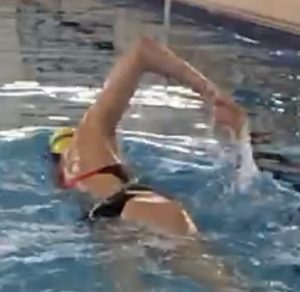What goes up, must go down
We know through science that for every action there is an equal and opposite reaction. Newton’s third law means that in every interaction, there is a pair of forces acting on the two interacting objects. The size of the forces on the first object equals the size of the force on the second object.
To swim and remain both balanced and stable it is vital you pay attention to what your recovery arm is doing above the water. If the mass of your arm is too high above you, it will push you down, if the arm pulls back behind you it will make you over-rotate. Any movement above the water that impedes the streamlining you are trying to achieve under the water will cause your arms and legs to ‘do something’ to balance out the instability, all of which is wasted energy and will not propel you forwards. It is also at the time your arm recovers that you are inhaling, breathing and remaining balanced and stable is a challenge and the recovery arm is vital to the quality of the breath and how your feel when you take it.
Think of the arm as the outrigger on the canoe, a side weight to give the vessel balance and stability. With fingers low to the surface of the water and the elbow wide and away from the body, this will keep your body, the human vessel both balanced and stable. This is an upper arm/elbow led movement, with forearms and hands relaxed, coming along for the ride, this wide, forwards movement encourages safe movement within the shoulder joint keeping the shoulder relaxed and loose, not impinged or hunched. The arm as a moving mass will also offer forward momentum and prime you to make a whole body weight shift as your hand and hips work together to drive you forward.
The word recovery also reminds us that the arm is returning to the start and finish of every stroke – the front. Our muscles are so clever that when we relax our arm for the time it takes to travel over the water the muscles get a rest, ready to apply ‘effort’ under the water.
The Thames Marathon is 14km and I can safely say the year I took part there was no tidal assistance to shorten the swim. I average 16 – 18 strokes per 25m with a push off, so if my maths is correct I took somewhere between 11,200 and 12,600 strokes to complete the swim, thats if I swam in a straight line, so let’s say 13,500!
As you build up to longer swims the repetitions increase, your arms will be grateful for the rest, your shoulder joint thankful for safe range of movement and that for the duration or your swim you, the vessel remained balanced and stable.



